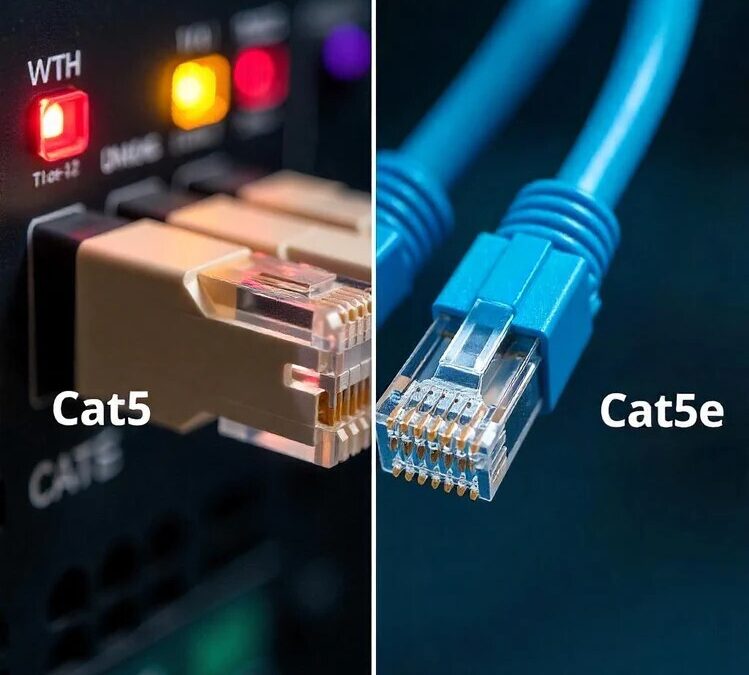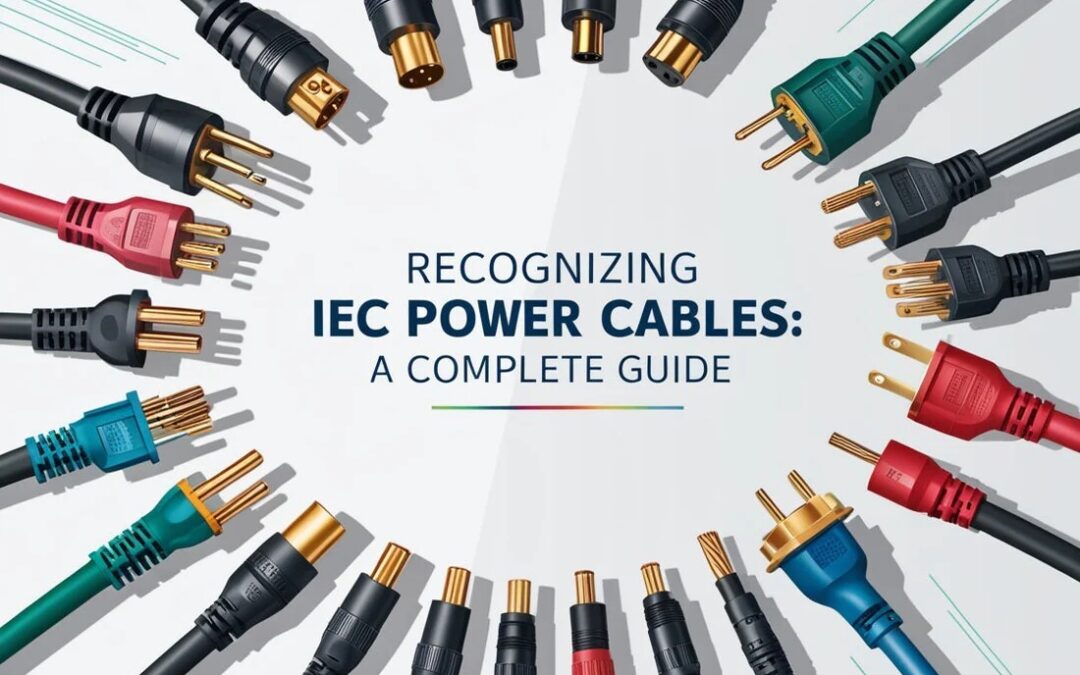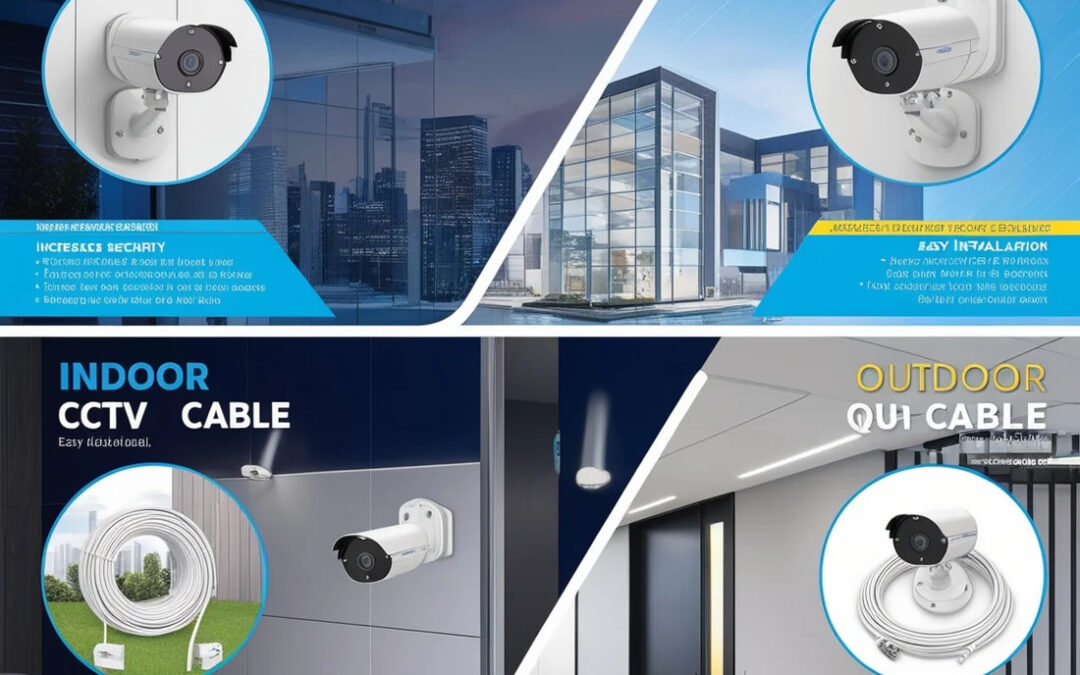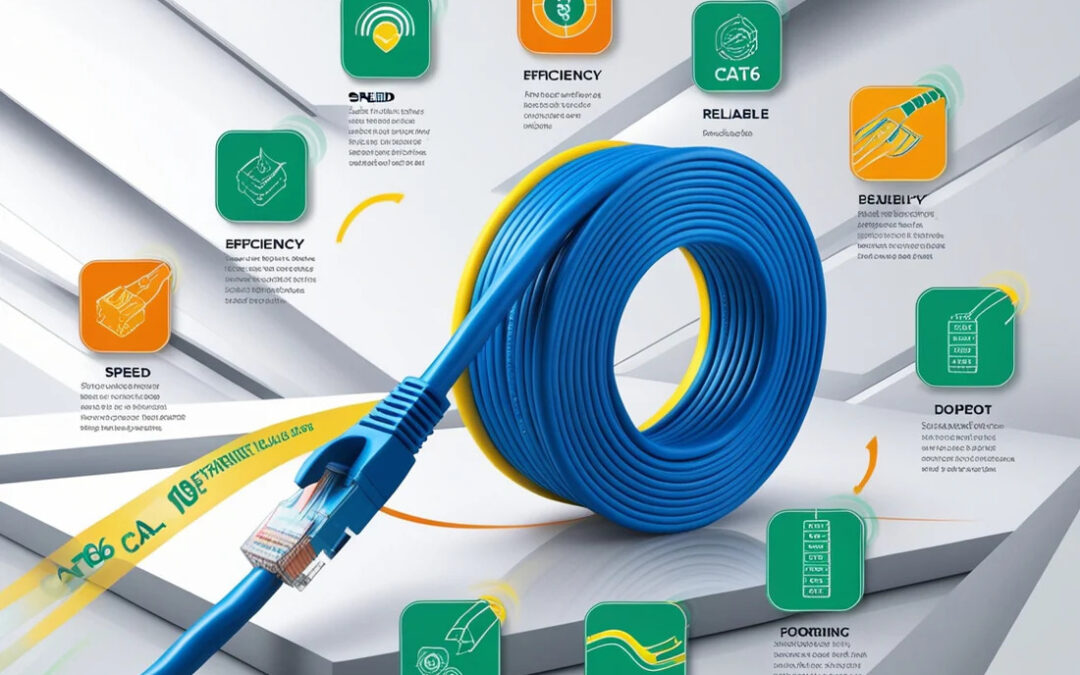
by fedus | Oct 17, 2025 | Technology
Introduction:
The important role of a strong networking system is important. Learning the various kinds of connections for Ethernet is important when building a home office, improving a corporate network, or increasing connectivity to the internet. Cat5 and Cat5e cables are two of the most popular possibilities. This blog will discuss the difference between Cat5 and Cat5e cables, particularly their features, applications, and place within the Indian environment.
What are cat5 and cat5e Cables?
Cat5 cable was launched in the 1990s and rapidly secured itself as the standard for local area networks (LANs). The cable is an unsecured twisted pair (UTP) that allows data rates of up to 100 Mbps and frequencies of up to 100 MHz. Cat5 cables are typically utilized for communication lines, computer networks, and video applications.
Cat5e cable is an improved variant of Cat5. Cat5e cables accept data rates of up to 1 Gbps (1000 Mbps) and manage bandwidths of up to 100 MHz, similar to Cat5, but display higher reliability due to advances in cable building design. These changes decrease noise and interference from signals, making Cat5e cables more dependable for high-speed networks.
Key Difference Between Cat5 and Cat5e Cables:
- Performance: The main difference between Cat5 and Cat5e cables is in their performance capabilities. Cat5 connections support transfer rates up to 100 Mbps, while Cat5e cables support speeds of up to 1 Gbps. Cat5e is better for modern applications requiring increased data transfer rates, including video conferencing, online gaming, and major file transfers.
- Speed: Both Cat5 and Cat5e cables allow a maximum speed of 100 MHz; however, Cat5e has been designed to reduce leakage (interference between wires). Although offering similar potential connectivity, Cat5e cables provide a stronger connection, particularly over longer distances.
- Crosstalk and Noise: Interaction relates to the undesired transfer of messages between communication channels. Cat5e cables feature higher noise requirements than Cat5 cables, making them less subject to noise. This is particularly important in areas where many cables are in close reach, including workplaces.
- Cable Production: Although both Cat5 and Cat5e cables utilize twisted pair wiring, Cat5e cables generally have stronger twists and improved soundproofing, which better decreases interference and protects signal quality. This design allows Cat5e cables to keep their quality over extended distances.
- Costs: Usually, Cat5 cables are cheaper than Cat5e cables. Still, the performance benefits associated with Cat5e usually warrant the price inequalities, particularly for applications requiring higher speeds and improved durability.
Application in India:
In India, the selection between Cat5 and Cat5e cables is mainly based on the specific application and the current network connectivity. Here are many typical conditions:
In this basic home internet requirements, including web browsing, video streaming, and social media, Cat5 connections may be suitable. Still, due to the growing number of smart homes and need for seamless connectivity throughout many devices, Cat5e cables are gaining popularity among homeowners looking to future-proof their networks.
A large number of small to medium companies in India have been looking to improve their networking capabilities. Although Cat5 cables allow for fundamental office functions, Cat5e cables are better for SMEs dependent on cloud services, VoIP, and video calls, where increased speeds and dependable connections are important.
Learning institutions in India are improving their networks of computers. Cat5e cables are often used in classrooms for their capacity to supply many devices continuously without major loss of signal. This is particularly relevant in environments where many students utilize online resources.
India’s growing technology sector requires flexible cabling solutions for data centers. Cat5e cables are usually used in these environments because of their capacity to manage rapid data transfer with no disruption.
As technology improves, networking hardware also improves. Though Cat5 and Cat5e cables continue to be used, they are slowly being replaced by superior-category connections that include Cat6 and Cat6a, which provide increased data transfer rates and improved performance. But for many applications, particularly in cost-sensitive environments, Cat5e continues to be an excellent choice.
Installation Considerations:
When installing Cat5 or Cat5e cables, adopting to best practices is necessary to achieving maximum speed:
- Avoid Electrical Interference: Maintain a distance between network cables and electricity wires to reduce impact.
- Use Proper Connections: Verify that connectors and outlets are compatible with the cable category in use.
- Limit Cable Length: Though Cat5e may maintain speed over extended distances, it is advised to limit cable runs to under 100 meters for the best results.
- Plan for Future Improvements: When installing new cabling, anticipate potential future speed requirements and choose properly.
Conclusion:
In summary, recognizing the difference between Cat5 and Cat5e cables is important for making informed decisions about network cabling in India. Though all cable types fulfill similar functions, Cat5e provides superior performance, less crosstalk, and enhanced bandwidth possibilities, giving it a more suitable choice for modern networking needs.
Fedus Company helps organizations and people in picking the correct cable for their needs, ensuring maximum performance and dependability in their network systems. Investment in Cat5e cables will improve both the durability and effectiveness of a networking environment, meeting the increasing needs of digital communications.

by fedus | Oct 17, 2025 | Technology
Introduction:
In the field of electrical technology and engineering, having a solid knowledge of power cables is important to maintaining both their safety and their efficacy. Power cables produced by the International Electrotechnical Commission (IEC) stand out among the many different kinds of cables that are available because of their continuously high level of reliability and universal standards. This complete guide looks into the value of IEC cables, their various types, the most typical applications for them, the requirements, the different types of connectors, and the benefits of using custom solutions.
What is an IEC Cables?
In IEC cables represent uniform power cables produced by the International Electrotechnical Commission, an organization that develops and communicates worldwide standards for electrical, electronic, and similar technologies. These cables provide flexibility and safety among various devices and systems, rendering them important in both industrial and consumer electronics.
IEC cables are engineered to transmit electrical power, identified by their different connector designs and defined specifications. They often feature in equipment requiring a stable power supply, offering a secure method to link devices to power sources.
Why do you need one?
The requirement for IEC cables develops from their safety and established qualities. Here are few reasons for their requirement:
- Safety: IEC cables are engineered to reduce dangers related to electrical connections. Their design includes protection and designated ratings to protect against overheating and electrical problems.
- Compatibility: These cables are universally compatible with many devices and manufacturers, providing simple connection among equipment.
- Processing: IEC cables are designed to support specific current as well as voltage ratings, providing reliable power delivery without affecting device performance.
- Usability: IEC cables, featuring standardized connectors, provide quick and simple connectors, therefore reducing setting up and maintaining them.
Types of Varieties of IEC Cables:
Many different kinds and designs of IEC power cables exist to satisfy particular technical needs and applications. Here are some common items together with their basic requirements:
- IEC C13 to C14 Connector: These are primarily utilized for computer displays, desktop PCs, and other devices, including printers. Their present rating is 10 A, with a voltage rating of 250 V.
- IEC C15 to C16 Connector: These cables, with a limit temperature of 120°C, work well for elevated-temperature locations including those near tea kettles or heating pumps. The maximum electrical capacity is 10 A, and the voltage must not be above 250 V.
- IEC C19 to C20 Connector: This cable type is usually used by high-power machinery, that includes computers or data center equipment, supporting currents up to 16 A and voltages reaching 250 V.
- IEC C5 to C6 Connector: commonly referred to as “cloverleaf” connectors, these cables provide connections between computers and certain projectors, among other equipment. Their present rating is around 2.5 A, while the voltage should fall within the range of 250 V.
Each IEC cable variant fulfills different purposes while conforming to international safety requirements. This indicates that no matter the kind selected, its design has been specified to fulfill the required technological specifications for secure connectivity in any application where it may be reliably utilized.
Common Use of IEC Cables:
An IEC cables have applications in various sectors, including:
- Computers and IT Equipment: Usually utilized for linking PCs, servers, and devices to power supplies.
- Home Appliances: Present in appliances like refrigerators, microwaves, and televisions, facilitating secure power transmission.
- Industrial Equipment: Applied in industrial and manufacturing facilities when machinery requires reliable electrical connections.
- Medical Devices: Important in healthcare environments, where reliable electricity is vital for life-support and monitoring devices.
The flexibility of IEC cables provides them a perfect match for an extensive selection of applications.
The Important of AWG in Power Cables:
AWG, or American Wire Gauge, is an accepted standard for measuring the diameter of electrical wires. recognizing AWG is necessary while choosing IEC power cables due to the following reasons:
- Current Bearing Capacity: Various AWG sizes are suitable for different current levels. Selecting the correct size ensures that the cable will suit the device’s power requirements without risk of heating.
- Voltage Decrease: Wires with greater depth (lower AWG numbers) exhibit less resistance, therefore minimizing voltage drop over extended distances, which is vital to keeping device efficiency.
- Safety: Using a suitable AWG mitigates the dangers of electrical fires and fails to function, thereby improving overall safety.
Common IEC Power Connector Types:
IEC C13 Connector: The IEC-C13 connector is among the most popular power connectors used globally. It is commonly located on computers, displays, and different electrical devices. Its tiny size facilitates simple connection and division, providing it a popular option in consumer electronics. The C13 connector is capable of supporting up to 10A at 250V, giving it suitable for most applications.
IEC-C14 Connector: The IEC-C14 connector is often used as an input connector for devices utilizing the C13 connector. It is usually attached to power supply and equipment. The C14 connector features a superior rating compared to the C13, capable of supporting up to 10A at 250V, and has been designed for use with C13 cables. The mechanism that locks provides a safe connection, minimizing the possibility of unexpected disconnects.
Other Famous IEC Connectors: C19 and C20: IEC-C19 and C20 connectors have been designed for high-power applications. The C19 connector supports a maximum current of 16A at 250V, whilst the C20 acts as the male opposite for connection. These cables are used in data centers and businesses requiring higher power, offering durable and secure connections for high-demand equipment.
Benefits of Custom IEC Cables
While common IEC cables fulfill many requirements, custom IEC cables provide specialized solutions for specific uses. The benefits include:
- Customized Specifications: Custom cables can be built to satisfy specific voltage, current, and environmental specifications, providing best performance.
- Length Options: You can indicate the exact length that is needed, decreasing excess cable to improve organization.
- Integration of Connectors: Custom cables may incorporate various connector types for sure compatibility with particular devices.
- Improved Resilience: These cables can be engineered using specialized materials and structure to withstand serious conditions, including high temperatures and exposure to chemicals.
- Opportunities for Branding: Cultural custom cables can be customized with logos or colors, improving professional features and identification of the company.
Conclusion:
In conclusion, analyzing IEC power cables is crucial for everyone working in electrical engineering, technology, or device production. IEC cables are required for reliable power transmission across devices and industries because of its standards, safety features, diverse applications, and connection types.
Using the right IEC cable, whether standard or unique, can improve the safety, efficiency, and performance of your electrical systems. Use the flexibility and durability of IEC cables to make sure that your power connections conform to the highest standards.

by fedus | Aug 23, 2025 | Technology
Introduction
In modern society, security is an important priority for homes as well as businesses. As security requirements increase, CCTV systems have become necessary. The success of these systems mostly depends on the quality of the installation wires. Fedus, a reputable company in the cable manufacturing business, provides a variety of indoor and outdoor CCTV cables to satisfy various surveillance requirements. This blog will examine the features and advantages of these cables, along with useful tips for their setup and maintenance.
Indoor Cables:
CCTV cables are required for the transfer of video and audio signals from cameras to recorders and monitors. CCTV systems utilize two main types of cables: coaxial cables and twisted pair cables (e.g., Cat5e or Cat6). The selection of these cables usually depends on the particular demands of the particular installation environment.
Features of Indoor CCTV Cables:
Indoor CCTV cables have been designed for inside locations where they have protection from environmental factors. Fedus provides a range of indoor cables defined by:
- Flexibility: Indoor wires typically exhibit greater flexibility, facilitating installation in narrow spaces and corners.
- Signal Quality: They are designed to minimize signal decay over short distances, therefore providing better video transfer quality.
- Economic Efficacy: Indoor cables are typically more economical than outdoor alternates, providing them an economical choice for indoor monitoring.
Benefits of Indoor CCTV Cables:
- Installation Simpleness: Their flexibility and lightweight features make indoor wires simple to route and install, even in complex designs.
- Reduced Influence: Indoor environments generally exhibit reduced electromagnetic radiation, resulting in indoor cables transmitting clearer signals.
- Visual Theme: These wires can frequently be hidden more effectively, increasing the visual appeal of interior environments.
Outdoor Cables:
Outdoor cables have been designed to survive external conditions including humidity, UV rays, and fluctuations in temperature. They are often used in communications, networking, and electrical applications. Categories include outdoor-rated fiber optic cables, Ethernet cables, coaxial cables, and power cables, all designed for durability and efficiency in challenging environments. These cables are crucial for linking devices and networks in outside environments, providing excellent reliability and performance.
Features of Outdoor CCTV Cables:
Outdoor CCTV cables are designed to deal with severe conditions outdoors. Fedus offers durable outdoor cables that feature the following characteristics:
- Weather Resistance: These cables are designed to withstand rainfall, snow, and high temperatures, using materials that withstand water and light damage.
- Durability: Their higher thickness and strength provide better defense against physical harm from animals or circumstances outside.
- Extended Transmission Range: Outdoor cables usually carry longer distances, ensuring that video feeds remain clear over a longer period.
Benefits of Outdoor CCTV Cables:
- Durability: The strong design of outdoor cables ensures their successful operation over extended durations, minimizing the necessity for frequent replacements.
- Versatility: Outdoor cables are used in various situations such as gardens, parking lots, and building exteriors, offering complete monitoring coverage.
- Superior Signal Transmission: Outdoor cables are engineered to reduce signal loss over extended distances, maintaining high-quality video feeds.
Installation Tip for CCTV Cables:
Proper installation is required for optimizing the functionality of your CCTV system. Here are some suggestions for ensuring the effective installation of Fedus CCTV cables:
- Plan the Agreement: Before installation, develop a detailed design of your CCTV system. Specify the positions of cameras, recording equipment, and paths for the cables.
- Use High-Quality Connectors: Investing in quality connectors that guarantee a reliable and safe connection. Weak connectors may result in reduced signal strength and reduced image quality.
- Reduce Electrical Interference: When installing cables, maintain a distance from electrical wires to decrease interference, which may affect video quality.
- Protect External Cables: Utilize protective conduits for outdoor installations to protect cables from physical harm and outside influences.
- Accurate Inspection: After installation, conduct an extensive inspection of the system to verify the functionality of all connections and confirm that the video quality matches your standards.
Maintenance Tips for CCTV Cables:
Regular maintenance can greatly increase the durability of your CCTV wires. Here are few maintenance ideas to consider:
- Conduct Periodic Inspections: Every day monitor the cables for indications of decline, fraying, or damage, particularly in outdoor installations subjected to outdoor conditions.
- Maintain Clean Connections: Check that connectors and connections have no dirt and moisture. Utilize compressed air to cleanse connections if required.
- Technology Upgrade: As technology advances, explore improving your cameras and cords to ensure compatibility with modern systems and optimized performance.
- Enter Your Installation: Document your installation, specifying cable types, lengths, and placements. This documentation is crucial for troubleshooting and future improvements.
Conclusion
In Conclusion, securing better CCTV cables, including those provided by Fedus, is vital for developing a reliable security system. Knowing the features and benefits of indoor and outdoor cables, along with keeping to proper installation and maintenance techniques, will substantially improve the efficacy of your surveillance system. A properly developed and carried out CCTV installation safeguards your property while providing comfort through proactive safety measures. Regardless of whether you are a home or a company owner, selecting appropriate CCTV cables represents an investment in your security that will provide benefits for years to come.

by fedus | Aug 23, 2025 | Technology
Introduction:
In modern society, connectivity plays a crucial role, and when technological advances occur, our needs for fast and effective communication also increase. Reliable and durable cabling solutions are critical for supporting high-speed internet and data transfer, whether for personal use, corporate networks, or large-scale data centres. Cat6 cables, the sixth-generation Ethernet cables, have become the primary component of network facilities, providing significant improvements compared to their previous versions. However, what separates Cat6 cables from others? This blog explores the top 10 benefits of Cat6 cables and their ability to improve network capacity enormously.
Top 10 Benefits of Cat6 Cables:
- High data transfer speeds
Cat6 cables’ exceptional capacity for high-speed data transfer is an essential benefit. Cat6 cables surpass Cat5 and Cat5e cables in performance, with a maximum speed of 250 MHz and the capability to support data transfer speeds of up to 10 Gbps (Gigabits per second). These qualities make them well-suited for tasks that need fast and secure internet connectivity, like online gaming, video streaming, cloud computing, and other similar activities. When in a residential or commercial environment, Cat6 cables offer continuous connectivity to satisfy the requirements of modern technology.
Developing solutions prepared for future needs is crucial to successfully keeping up with the quick pace of technological advances. Cat6 cables are specifically engineered for more frequencies and data transfer, so your network is well-prepared for future improvements. Because of the growing popularity of Gigabit Ethernet and faster internet services, Cat6 cables provide a high level of future-proofing, ensuring that your network will stay efficient for an extended period. By installing Cat6 cabling right now, you can avoid the work and cost of multiple upgrades soon.
- Improved Signal Quality and Noise Reduction:
Signal interference and noise can impair network performance, resulting in data transmission mistakes and reducing connection speed. Cat6 cables include a better twisted-pair design and superior protection than their predecessors. This reduces noise (interference between cable pairs) and electromagnetic interference (EMI) from nearby devices. This implies that data is transmitted with improved integrity, enabling straightforward, reliable communication throughout your network. The outcome is improved signal quality and fewer interruptions, even in environments with significant electromagnetic interference.
- Supports High Bandwidth Applications:
Given the increasing use of data-intensive applications like 4K video streaming, virtual reality (VR), and cloud services, greater speed demands. Cat6 cables are highly effective in these situations since they offer the bandwidth required to support data-intensive applications without losing speed or reliability. This is particularly useful for businesses that depend on immediate access to data, video conferencing, and transferring huge files. Cat6 connections ensure your network can effectively manage high-bandwidth requirements without facing a delay or decrease in performance.
Cost is essential for people and businesses when selecting the right cabling solution. Although Cat6 cables are more advanced than previous Ethernet standards, they are affordable and cost-efficient. Although the cost difference between Cat5e and Cat6 cables is slight, the more powerful benefits of Cat6 cables make them a more practical long-term investment. For enterprises, increased velocity, dependability, and future-proofing capacities can result in higher efficiency and decreased periods of inactivity, leading to long-term cost savings.
An essential characteristic of Cat6 cables is their ability to work with previous Ethernet standards like Cat5 and Cat5e, even if they were developed later. This means you can incorporate Cat6 cables into your current network architecture with all your devices or equipment. Reliability facilitates a seamless and less disruptive move to a faster and more efficient network, helping you enjoy the benefits of Cat6 cabling without requiring an extensive network rebuild.
- Wide range of applications:
Cat6 cables provide exceptional flexibility and can be employed across an extensive range of applications, from home internet connections to enterprise-level data centres. These devices are suitable for both indoor and outdoor applications. They can perform various networking functions, including Voice over IP (VoIP), video conferencing, online gaming, and other duties. Cat6 cables’ adaptability makes them a superb option for various situations and applications, providing the full benefit of your network infrastructure.
- Durability and Longevity:
Aside from their technological prowess, Cat6 cables are designed for long-term durability. These products use premium materials with greater strength and resistance to decay and harm. Their reliability makes them suitable for indoor and outdoor applications, including challenging locations. The strength of Cat6 cables ensures an extended lifespan, minimising the necessity for regular replacements and offering a cost-efficient resolution for long-term network installations. Whether a domestic network or an expansive enterprise system, Cat6 cables provide the durability required for reliable and consistent performance over a long time.
- Improved Network Efficiency:
Improving network efficiency is essential in the rapidly evolving digital environment since any inactivity can lead to significant disruptions. Cat6 cables increase network efficiency by minimising latency and lost packets across your network. This is crucial for enterprises that depend on fast and effective communication among devices and systems. By utilising Cat6 cables, you can maximise the efficiency of your network, leading to improved productivity and a superior user experience.
- Benefits for the Environment:
The importance of environmental responsibility in modern technological solutions is growing, and Cat6 cables align with this current trend. Many Cat6 cables are produced utilising eco-friendly materials that adhere to RoHS (Restriction of Hazardous Substances) regulations. Moreover, due to their strength and extended lifespan, Cat6 cables minimise the need for regular replacements, reducing electronic waste. For those looking to minimise their environmental impact, Cat6 cables provide a green option that maintains high performance.
Conclusion:
In Conclusion, when connectivity has become crucial for personal and professional communication, Cat6 cables provide a reliable, future-proof solution for data transmission. Cat6 cables benefit households that request a trustworthy online experience and online businesses exploring ways to improve network performance. These cables address today’s and tomorrow’s networking needs with high-speed data transfer, increased signal quality, cost-effectiveness, and environmental benefits.
Cat6 cable investments are about future readiness as well as current needs. As technology evolves, a stable and efficient network infrastructure is crucial. Adopting Cat6 cables ensures your network can quickly and efficiently handle modern difficulties.




